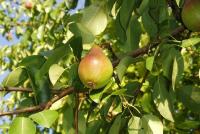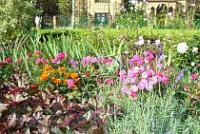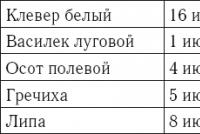Compatibility of fruit trees shrubs. How to plan a garden? Compatibility of fruit trees and shrubs
Many gardeners are interested in how to properly place fruit and berry crops in their plot, so that they grow well and bear fruit. As in a small garden area, different varieties and breeds will influence each other. After all, a garden is always preceded by a lot of preparatory work. Assessment and selection of sites is carried out taking into account the suitability of the soil for planting, and the mistakes made are often difficult to correct.
Our gardeners often do not have to decide on the choice of sites. But it is important to know their features and if possible try to correct the shortcomings.
Bad soil for garden bookmarks
Sprayed, highly podzolized, marshy, stony and dense clayey soils are undesirable. Absolutely unsuitable for laying a garden swampy, closed pits and hollows. For fruit plants dangerous areas with high standing of groundwater. On such sites the plants are short-lived. The roots of fruit trees, having reached the water, die off from lack of air, then the ends of the branches dry up, and the skeletal branches begin to die off.
Groundwater level at planting
When planting apple and pear, the groundwater level should be no closer than 2 m from the soil surface. Cherry and plum, having less deep-reaching roots, can be planted at a depth of groundwater not closer than 15 m, and currants, gooseberries, raspberries - if there is groundwater at least 1 m.
Useful and harmful trees - neighbors of the garden
It has been experimentally established that if tree species such as oak, maple, linden, bird cherry grow near the garden plot, then fruit plants will grow well. But if in the neighborhood grow alder, sedge grass, horsetail - all this speaks of swampiness and increased acidity of the soil.
Usually in a small garden area grow various pome, stone fruit, walnut and berry crops. Apple trees, pears, cherries, plums, raspberries, gooseberries, currants and nickname are compatible with each other, which allowed them to grow together for centuries in a limited area of the garden. A big mistake when placing fruit trees are thickened planting. Each fruit plant for normal growth and fruiting requires an adequate amount of soil and air throughout its life.
Distance between seedlings
When establishing the distance between fruit seedlings during planting, it is necessary to consider, first of all, the size of the crown in width. The closure of crowns of neighboring trees, and even more so the intertwining of the branches, worsens the illumination inside the crown, as a result of which premature death of the overgrowing and fruit branches inside the crown occurs. In addition, spraying, pruning and harvesting are greatly hampered with closed, intertwined crowns.
Temporary compacted planting can be carried out by placing currants, gooseberries, and strawberries in the rows of young fruit trees. As the trees grow, the latter are removed from the garden row spacing.
An excessive increase in the distance between the berry bushes and fruit trees is also impractical, as the number of plants per unit area decreases, and the total yield of berries and fruits decreases.
Placement of trees on the site
Fruit crops have different winter hardiness, so they need to be placed so that tall apple trees, pears grow from the north or north-east side of the plot, do not shade other plants and protect them from strong winds.
On home gardens, where the processing is carried out mainly by hand, you can place an apple and pear at a distance of 4-5 m from each other, and cherry and plum - at a distance of 2.5-4 m.
Pollination of plants
In addition, the placement of varieties of each crop must be such that it contributes to the best mutual pollination or, as they say, the best cross-pollination. In fruit species (apples, pears, plums, cherries), there are varieties of self-fruiting and self-fruitful. The first ones tie fruit when pollinating with their own pollen, the latter - only when pollinating another variety. Almost all of our fruit self-sterile, and for normal pollination and fruiting need to plant several different varieties.
Observations have shown that between different varieties of fruit trees, which should pollinate each other, the distance should be no more than 20-25 meters. Bumblebees, bees carry pollen from one variety to another.
Cherry, sea buckthorn, and raspberry produce shoots; therefore, it is impossible to plant strawberries in close proximity to them. In addition, raspberries and strawberries have a common pest - strawberry-raspberry weevil.
Placing fruit trees on the plot
Often the gardener has a question, how much and where to plant plants of a particular breed? Placing plants on the site - a personal matter. Most garden plots are of consumer value, i.e., they are used to obtain a variety of garden products to meet the needs of the family for berries and fruits.
Some gardeners deliberately give preference to one or another crop, such as strawberries, and get crops that exceed their own needs for sale. There are gardeners who are interested in not just the harvest of fruits, but the cultivation of some rare species and varieties grown in an unusual way, such as grapes, walnuts, etc.
The photographs are examples. In the first scheme - Placement of fruit trees in the area of 4 acres, in the last photo - the layout of the site 24 x 40 m.

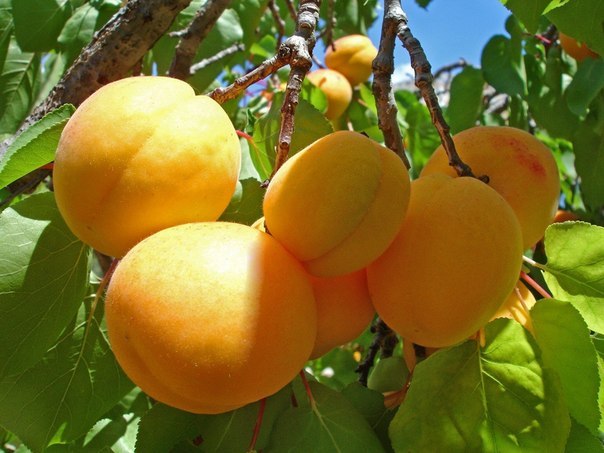
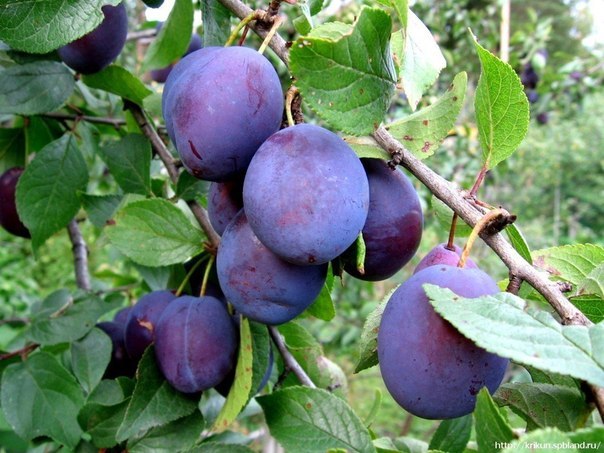
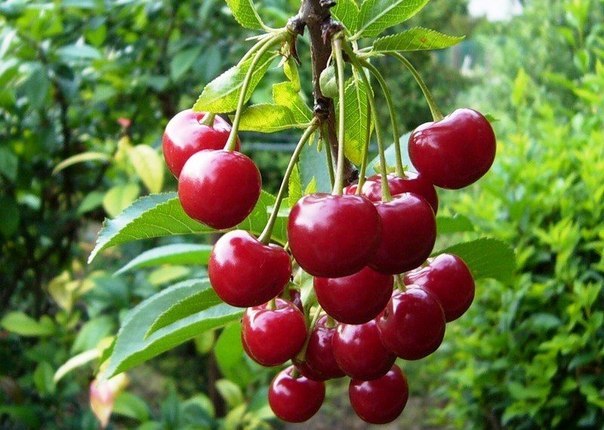
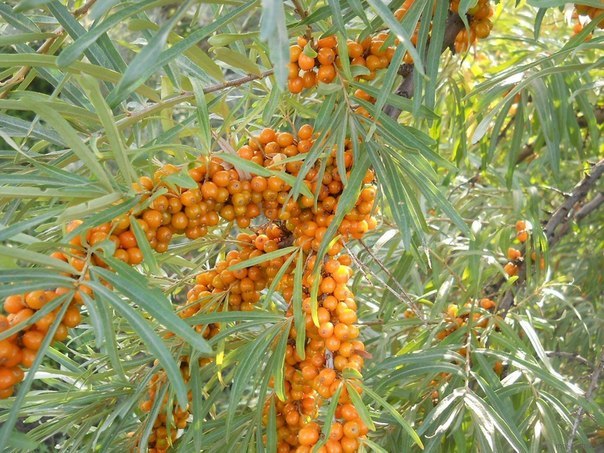
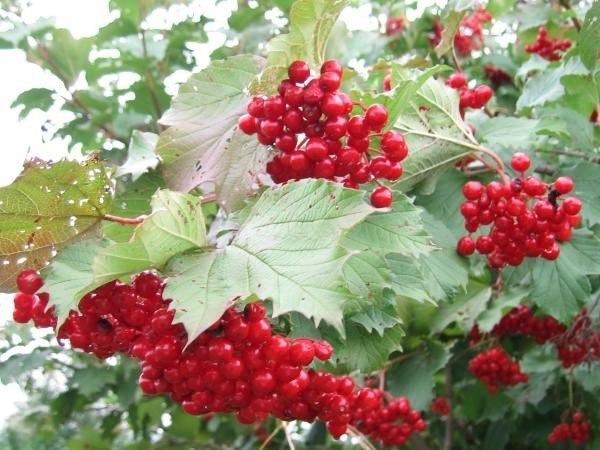
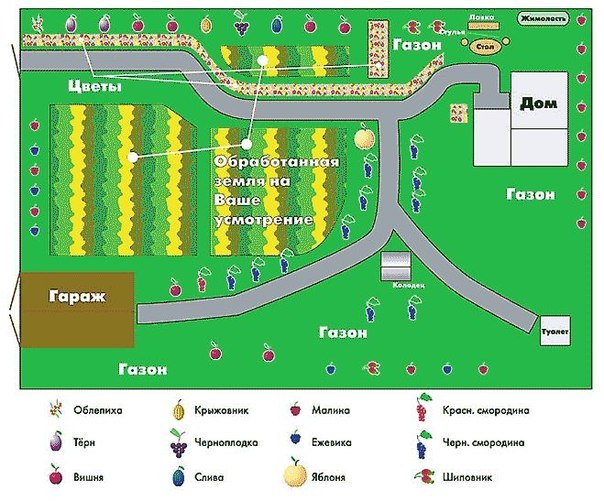
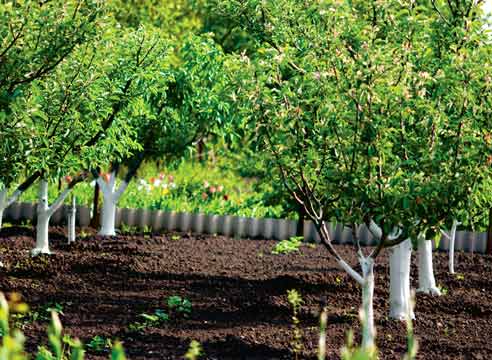
When planning the placement of crops on the site, each gardener should consider the following main points. In the garden, fruit trees grow in one place for a long time, often for decades.Therefore, before laying the garden, you need to think carefully about everything, determine the desired set of fruit crops, the number of plants required for planting, calculate the area for their placement, make a plan for your future garden. And only after that proceed to landing.
Most garden plants are very light-loving and give a good harvest only with sufficient sunlight. Therefore, a strong thickening of landings, as well as placing them in the shadow of buildings or tall trees is undesirable. Your plantings also should not interfere with neighboring areas and shade them. Therefore, trees on strong-growing rootstocks are planted no closer than 3 m from the edge of the site, and bush berries - 1 m.
Breeds that require a large number of treatments with plant protection chemicals (winter varieties of apple, pear) are located away from home. Closer to it planted stone, walnut, grapes.
The minimum distance between the trees should be equal to the sum of the heights of the adult trees, which will make it possible to achieve optimal fruitfulness and comfortable care.
One of the trends of modern gardening is the compaction of plantings by increasing the number of trees and shrubs per unit area without compromising their fruitfulness. This is achieved by artificially limiting the crown and special pruning to create its various forms. Standard and semi-tumbling forms are considered obsolete due to their bulkiness. Nizhkoshtambovaya with a height of 3–3.5 m and a crown width of 2–2.5 m are increasingly used. However, the size can be varied depending on the type of fruit tree. For smaller gardens, it is better to choose the shape of a pygmy pyramid, cordon or palmette. They look beautiful and at the same time rational.
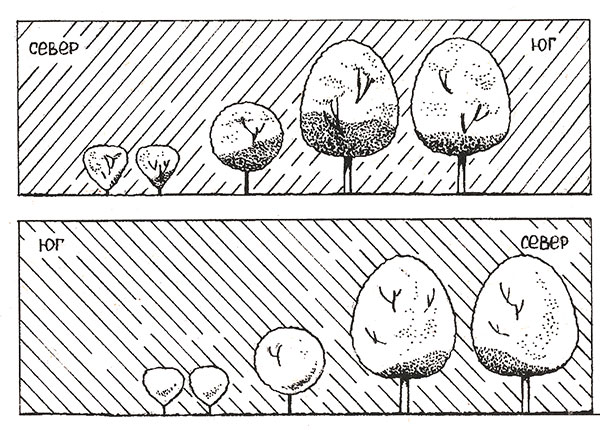
Orientation to the cardinal points is also one of the most important factors. Almost all fruit and berry plants prefer the sun and do not tolerate shading (especially light-requiring strawberries, raspberries, gooseberries, sea buckthorn). Partial shading (half a day) can withstand black currants. In order for the sun to reach everyone, it is better to observe the principle of layering: from the south side they plant the strongest (strawberries), behind them - higher shrubs (currants, gooseberries), then - medium growth trees (cherries, plums) and, finally, the highest (apple pears, sweet cherries).
In a small area, the best illumination for plants is achieved with stepwise placement, taking into account the directions of the light. It is good when the long side of the garden goes from south to north or from southwest to northeast.
The tree planted on the south side will abundantly bear fruit, so in this case the best conditions for its growth and development are created. In the south and southwest, heat-loving plants are planted: apricots, cherries, peaches, winter pear varieties. It creates an excellent microclimate, which is characterized by good illumination and protection from the wind. Black currants can be planted without any doubts along the northern border of the plot, and red currants and gooseberries can be planted on the western or eastern side along the fence of the plot. Partially currant bushes are also planted in the main rows between fruit trees, only you need to remember: in this case their lifespan is limited to 12-15 years, as the trees crown grow and, closing in, ultimately deprive them of light.
It is necessary to take into account the fact that fruit trees and berry bushes in the garden, planted next to or in joint plantings, may turn out to be “good” or “bad” neighbors. In the first case, they have a beneficial effect on each other, attract bees to better pollinate the "neighbors" and even protect against pests. In the second case, the plants are affected by common diseases and oppress each other.
Apple tree gets on with a pear, cherry, plum, a quince, an apple-tree. Poor transferring neighborhood with cherries, viburnum, golden currant, barberry, lilac, Chubushnik.
Pear it will grow well next to an apple tree, red rowan, a pear, and in the immediate vicinity of cherries or cherries it will constantly hurt. It is also oppressed plum, viburnum rose, lilac, Chubushnik, barberry.
For cherries Appropriate neighbors will be apple, grapes and cherries.
Plum gets on with an apple-tree and plum, but not with a pear.
Apricot and Peach. If you decide to place an apricot next to an adult peach tree, keep in mind that a peach, if it is located from an apricot at a distance of up to 2.5 m, will certainly be oppressed by young apricot seedlings. Even if the shade of the peach on the seedlings will not fall, the trees will still grow as if they had been specially bent away from the peach.
Peach and cherry (or sweet cherry) A peach is able to grow next to a cherry or sweet cherry only at a fairly decent distance of at least 6-7 meters. Otherwise (that is, with closer planting), that side of the peach that is adjacent to the undesirable neighbor is exposed. On these branches, gum development and gradual drying will begin, and freezing will occur in winter. The opposite side of the peach crown will try to avoid cherry or cherry as much as possible. Moreover, the angle of inclination can reach 45 degrees. It is clear that a crooked and diseased tree is unlikely to decorate a plot, and it will not bring any benefit in terms of yield. Usually, as experts emphasize, the peach tree lives in close proximity to the cherry or sweet cherry for no more than 4-5 years, after which it disappears. Everything else worth adding that the cherry (cherry) nearby with a peach feels depressed.
Peach vs pear and apple
Does not like peach as a pear and apple tree. If they "breathe in the back of his neck" to him, the peach will certainly begin to oppress the neighbors. Accordingly, it is not recommended to locate these trees at close distances from each other.
Walnut prefers loneliness
Walnut leaves and black nuts contain juglon, a substance with very strong herbicidal properties. Being washed out from the leaves during rains, the juglon gets into the soil and destroys any vegetation under the crown of the tree. But walnuts are especially disliked by the apple tree, which, with its secretions, not only damages, but kills.
Raspberries planted separately, away from black currants and strawberries.
Gooseberry and currant they also do not recommend placing them side by side, since they have common diseases and pests.
Not having much experience in gardening, you can easily make a lot of mistakes. As a result, fruit and berry trees may not give the harvest and even die. For example, is it possible to plant an apple tree next to a cherry? If not, why, and with what neighbors does she get along?
Why compatibility is important
There is a science that studies the compatibility of plants.
An apple tree cannot be called a friendly neighbor. It has a well-developed root system. The plant needs various minerals and a large amount of water, so the roots are able to take what is needed from other plants, restricting their development.
When planning a garden, you need to know if you can plant an apple tree next to a cherry. Like other stone fruits, cherries do not get along with apple trees. And in this conflict, it is stone fruit plants that suffer. Apple tree does not allow them to fully develop, selecting food. Therefore, such a neighborhood will lead to a lack of harvest of cherries.
How to ensure a good harvest of apples
Apple trees are not self-pollinated plants, they need the help of insects. To ensure cross-pollination, it is necessary to group several plants of the same species together. Where to plant an apple tree, if not among their own kind?
Excellent neighbors for her will be:
- Chives. It is planted around a tree trunk to scare off harmful insects and attract useful ones.
- Korovyak protect from bugs, destroying young fruit.
- Fennel attracts insects that eat the caterpillars;
- clover creeping saturates the soil with nitrogen, attracts insects that destroy pests. The blooming period of clover and apple is the same, so it attracts insects for timely pollination.
In order not to lose a place in the garden, from the sunny side under the apple tree you can plant early varieties of tomatoes.

What trees are good and bad combined with apple trees
Can an apple tree grow next to a cherry? These two trees can be located in close proximity, but the harvest can not count. Instead, it is better to plant a coniferous tree in an apple orchard, such a neighborhood accelerates the development of fruit trees and guarantees a good harvest.
Interfere with the normal development of apple viburnum, lilac, horse chestnut.
Many are interested in whether it is possible to plant an apple tree next to a cherry or raspberry.
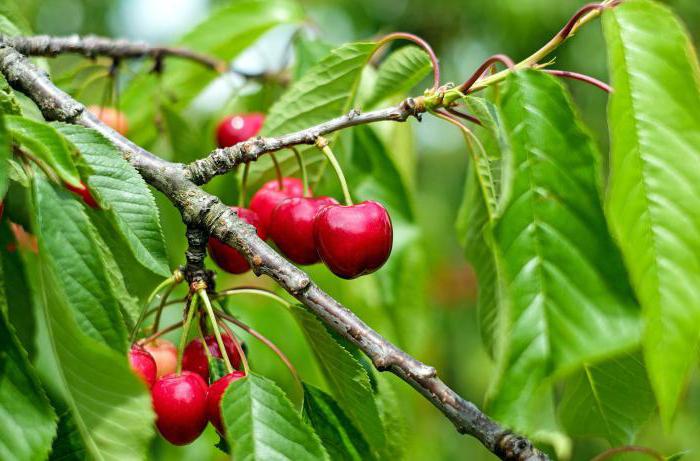
Although many gardeners believe that as neighbors, raspberries and apple trees behave quite friendly.
Soil for an apple tree
The plant prefers loose soil, clay does not suit him. For heavy soil, add sand or peat, humus or compost. If the soil is peaty or sandy, you must add clay, compost or humus to it.

An ideal location for an apple tree is a hill located far from the groundwater. If there are difficulties with the provision of such conditions to the tree, it is necessary to create an artificial hill from fertile soil about 0.8 m high. As the plant develops, the land will need to be filled.
The pit is prepared a few weeks before landing. It should be dug to a depth of 0.8 m with a diameter of 1 m. The soil for the apple should be well cultivated, so you need to make two buckets of rotted manure, one cup of superphosphate and a little ash. The young plant needs a support, therefore a peg is dug into the center of the pit.
Apple tree planting time
In order for the planting material to take root, it is important to choose the right time for placement on the site. One of the criteria for choosing the period when it is worth doing is the climatic conditions of a particular region. For central Russia, spring and autumn are suitable. When planting in the spring is better to work in the second half of April. In the autumn works - in the first half of October. In similar periods, young growth is traditionally planted in the south of the country.

In the northern regions, planting apple trees with saplings in spring is the only way to ensure that the plant has time to settle down. In this work can be performed only when the earth is already warm enough. The pit can also be prepared in the fall.
Selection of seedlings
For planting apple trees in spring, seedlings need to choose high-quality planting material. You must carefully consider the appearance of the seedling. A young tree should have a label with the name of the variety and recommendations for which climate it best suits.
When buying it is important to pay attention to the quality of the roots. The tree can be sold with an open root system or with a lump of earth. Hidden from the eyes of the roots can sometimes have defects, so it is recommended to make a choice in favor of the specimens with the roots freed from the ground. It is important to pay attention to their integrity and color. They should be bright, without dark spots or growths, the root system should be well developed.
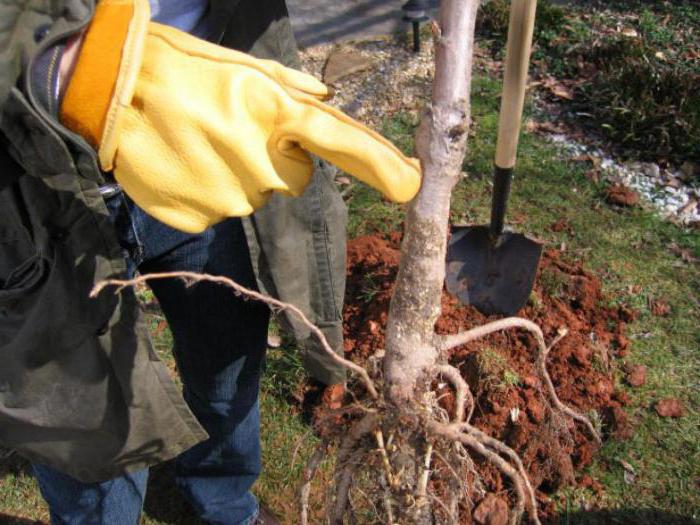
If you choose a bad sapling, it doesn’t matter at all whether you can plant an apple tree next to a cherry tree - the result will be deplorable. A good sapling should be about one and a half meters high. Smaller heights may indicate poor-quality care, and too high specimens indicate a violation of the technology of growing planting material.
When buying, it is better to choose young trees, which are 1-2 years old. This is due to the inability to extract a more adult seedling from the ground with full preservation of the root system. Young trees are easier to recover from transplanting than older ones.
Can I plant an apple tree next to a cherry? No, in order for the trees to produce a permanent crop, they should be divided and planted next to other plants.
The fruitfulness of the garden in the first place depends on the correct landing. For a good survival rate, planting young in a permanent place, you need take account of
. Relying on it and maintaining the desired distance between the plants, the chances of engraftment of an individual seedling grow many times.
Landing pattern
Planting of young stock begins with the preparation of pits. The exact location of the pits should be pre-calculated and demolished in a special landing scheme. When creating such a plan, it is necessary to take into account the minimum step between fruit-bearing plants, as well as the compatibility of trees and shrubs in the garden. Only in this case the garden tab will be crowned with success.
For optimum fruitfulness and comfortable care, the minimum distance between trees should be equal to the sum of the heights of adult trees. Even if the compatibility of trees in the garden is at a high level (all the plants get along perfectly with each other), it is not worth reducing the step between them. Too small a distance between young stock in the future will lead to undesirable results (lack of sunlight, crowns woven between themselves, etc.).
The success of planting depends on the selected places for seedlings. Therefore, it is advisable to draw up a scheme with professional gardeners. They will not only take into account the compatibility of trees during planting, but also carefully study the terrain (light, soil characteristics, water occurrence, etc.). Our experts will determine the best places for planting young, so that the future garden will bear fruit well and bring a huge quality crop.
together
First of all, when planting it is important to estimate how the future fruit-grower will grow. Despite the good fruit tree compatibility among themselves they will interfere with each other in the future due to the faster growth of one of them. Tall plants can simply block the access of sunlight to small trees.
Perfect compatibility of fruit trees is achieved by planting plants of the same species: apples with apples, cherries with cherries, etc. However, a garden of the same type in the yard is unlikely to bring much joy and pleasure. Experienced horticulturists noticed certain trends in the development of various neighboring cultures (some get along with all 100, others try to survive a neighbor). Especially for you, we have compiled a tablet in which we noted how certain trees can live alongside other plants.
Fruit tree compatibility
Table for a successful landing:
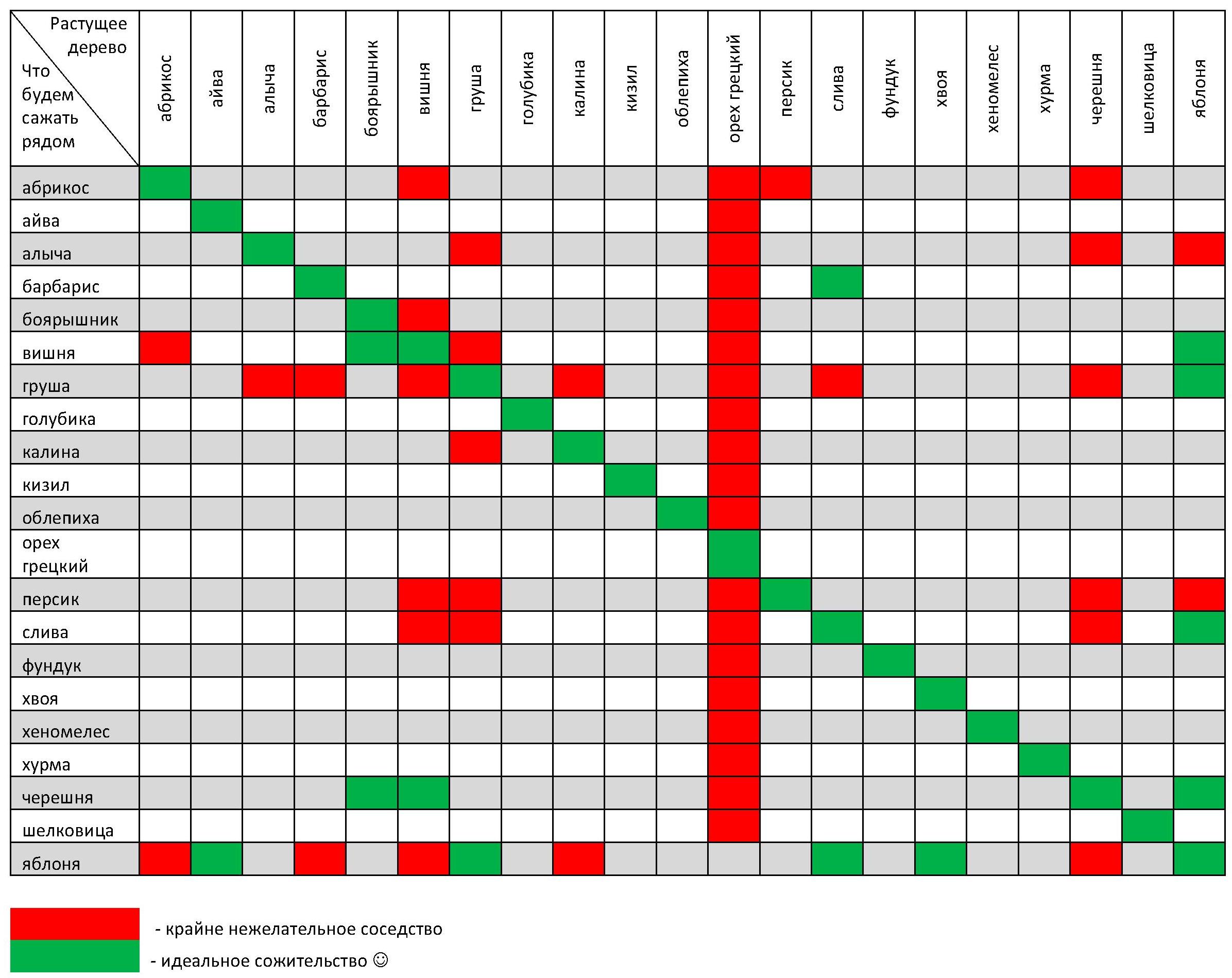
It is difficult to imagine an orchard in which such a wonderful tree as a cherry would not grow. The fruits of this culture are in great demand, because they make jam from cherries, make jam and compotes, squeeze juice, add it to sweets and pies. Let's take a look at how to plant a cherry in the spring correctly, so that next summer we will get the first crop.
Purchase of planting material
For planting cherries are considered as suitable both own-rooted and grafted plants with 3-4 branches of skeletal roots. It is worth noting that root-bearing crops obtained from shoots or cuttings are restored more quickly after winter freezing. At the same time, grafted plants yield earlier.
Along with the biennial, you can purchase annual seedlings with a well-developed root system. Usually, the height of two-year-old seedlings averages 1 meter, while the one-year-olds reach only 70-80 cm. If the leaves are not removed when buying plants, then this should be done immediately after coming home, otherwise dehydration of the seedlings can occur. The roots of the acquired trees must be moistened, then wrap with a damp cloth and film. This will help protect the planting material from drying.
Seedlings storage
Gardeners argue that for spring planting saplings is better to buy in the fall and dropping them for the winter. For this purpose, as a rule, they dig a trench, the depth of which should be at least 50 cm. On the south side, it is necessary to run its wall at an angle. Lay the seedlings in a row, so that their crowns are facing south. This arrangement of planting material helps to prevent sunburn on the trunks. 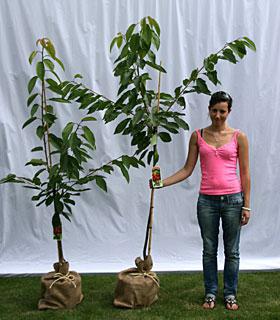 After backfilling the soil is required to press firmly to the roots and water well. The damp earth conscientiously fills all the voids through which cold air could penetrate to the seedlings. It is recommended to put fir spruce branches around the trench, which is an excellent means of protecting planting material from mice.
After backfilling the soil is required to press firmly to the roots and water well. The damp earth conscientiously fills all the voids through which cold air could penetrate to the seedlings. It is recommended to put fir spruce branches around the trench, which is an excellent means of protecting planting material from mice.
Choosing a place
The question of where to plant the cherries, all novice gardeners are interested. In fact, a lot depends on the right place: durability and productivity of the plant. Planting is recommended in protected areas, which minimizes the chance of winter damage.
Also, choosing a place, it is necessary to take into account that the cherry begins to bloom early in the spring, and its flowers are often damaged by frost. Of great importance is the protection of the tree from the winds, which in the winter season increase the risk of freezing, and in the spring they interfere with the work of bees, dry the pistils of flowers, thereby reducing fruit set.
So, how to plant a cherry in spring, which place should I choose? Most experts believe that it is best to have a cherry in the upper and middle parts of the gentle slopes of the southern, western and south-western directions. The eastern, northern and northeastern slopes are considered less suitable. 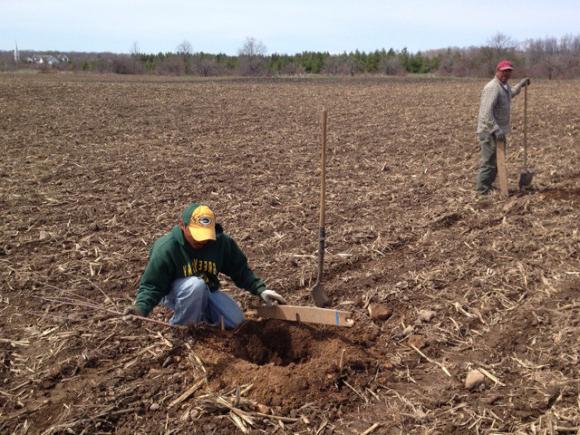 When choosing a site, it is necessary to take into account the depth of groundwater, the proximity of which inhibits trees. So, it is important that the groundwater passes no closer than 2 m from the soil surface.
When choosing a site, it is necessary to take into account the depth of groundwater, the proximity of which inhibits trees. So, it is important that the groundwater passes no closer than 2 m from the soil surface.
Soil preparation
How to plant a cherry in the spring? Great importance is given to the preparation of the soil, which should be carried out in the fall. So, it is necessary to dig up the earth and make various fertilizers (organic, mineral, complex).
Fertilization
Speaking about how to plant cherries in spring, it is important to note that in order to ensure good nutrition of the tree, fertilizers are brought not only under the digging of the earth, but are added directly to the planting pits. However, in this case, you should not use lime and nitrogen fertilizers, as they can worsen the survival rate of seedlings and cause root burns. Experienced gardeners recommend adding up to 15 kg of humus, aged compost or non-acidic peat, 500 g of ash, 60 g of potassium sulfate and 200 g of superphosphate to the landing pit. Pits need to be dug and fertilized 14 days before the proposed planting day. 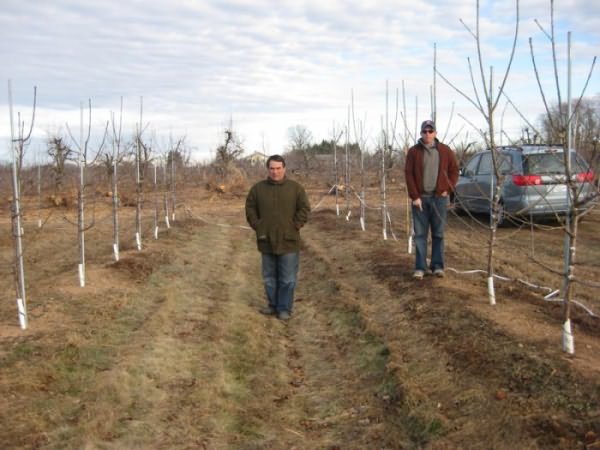
Landing
How to plant cherry in the spring, at what time is best to do it? As practice shows, the earlier in the spring cherry seedlings were planted, the better they will take root. Therefore, it is recommended to start planting immediately after the snow melts and the soil dries out slightly.
Plant survival is directly dependent on the condition of the seedlings. On the eve of planting, planting material should be inspected and cut to a healthy place damaged roots and shoots. The seedlings delivered to the intended location of the garden should be temporarily prikopat, and immediately before posting them to the planting holes dip the roots in a soil or clay dung trash.
Every experienced gardener who knows how to plant a cherry in the spring argues that the correct determination of the planting depth is of paramount importance in this process. So, the root neck of a tree should be located at the level of the soil, and therefore when planting should take into account the subsidence of the soil by a few cm (from 2 to 5 on average).
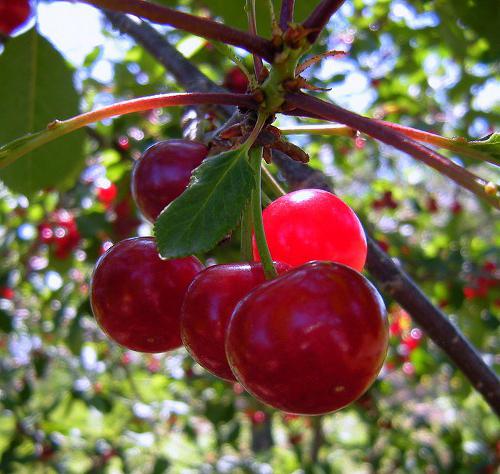
For planting cherry seedlings, it is necessary to dig holes, the depth of which should be 50 cm, and width - 80 cm. When digging a hole, the top layer of soil should be discarded separately from the bottom. It is required to install a planting stake in the center of the pit and pour around it a mound of topsoil mixed with mineral and organic fertilizers.
It is more convenient to plant together: one person sets up a sapling, spreads its roots in different directions and fixes the future tree in this position, while his partner falls asleep to the roots, using for this the soil of the upper layer. It is necessary to fill the hole with earth, trample the soil around the trunk with a foot and pour the newly made tree with 2 buckets of water. At the end of the planting, sprinkle the soil around the tree with peat, loose earth or humus, which will preserve moisture and prevent the formation of a crust.
Since planting a cherry and growing it is not an easy task, you will have to set yourself up for a long labor process, because the plant loves attention and care. And in gratitude for all the work already after a year you can get a fruit tree with very tasty and juicy fruits.
fb.ru
bought apricot, apple, sweet cherry and cherry what to plant next to what?
vasily Antonyuk
There is a difference. Stone fruit plant near, only 2 meters is obviously close. In stone fruit, interoperability, apricots, peaches, cherries, cherries are recommended to be planted next to each other, BUT not for the place of the same old tree, everything useful has been exhausted. And apple tree, pear also love the neighborhood.
All the next year I come to help harvest.
At D And Ch And !!!
Mustafa
There is no significant difference. Plant at your discretion, the main thing is that at a distance of no closer than 2m
Konstantin
2. If the sweet cherry is planted next to the apricot, then the apricot will not give fruit.
An apple tree can be planted next to a cherry and apricot, but the apricot is far away from the cherry.
Tatyana
Within a radius of 8 meters from your sweet cherry, there must be another cherry tree, otherwise there will be few ovaries. We, too, first planted one tree, and then had to set down a couple, since the neighbors did not have a single cherry around. This is in addition to the rest of the answers.
Is it possible to plant sweet cherry seedlings next to apricots, cherries, apples?
Gene Abonos
Can. Just remember, sweet cherries are very large trees. The situation is fully extended to them: the branches of neighboring trees have touched - do not expect fruits on them.

